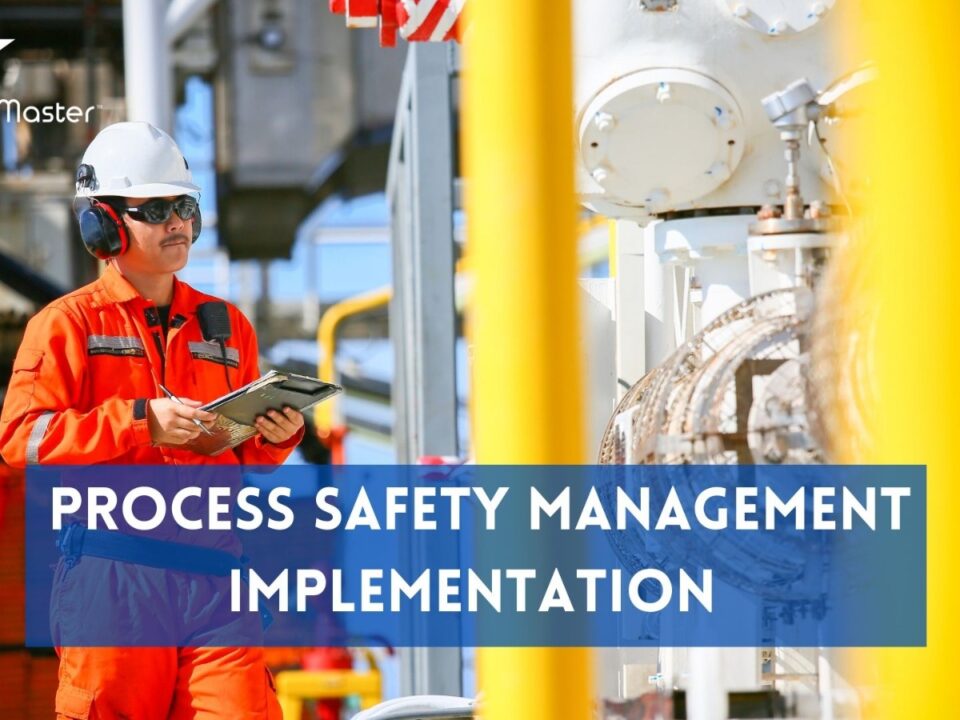Process Safety Management Implementation by TheSafetyMaster

HAZOP, Safety Integrity Level Assessment and LOPA study by TheSafetyMaster
August 23, 2023
Process Safety Management Training by TheSafetyMaster
August 23, 2023Process Safety Management is a critical aspect of ensuring the safety and well-being of employees, communities, and the environment in industries that deal with hazardous substances. The implementation of effective process safety measures is not only a legal requirement but also a moral obligation for organizations. However, navigating the complexities of process safety management can be challenging without proper guidance and expertise.
In this comprehensive article, we delve into the world of Process Safety Management Implementation by TheSafetyMaster, a renowned expert in the field. We will explore key elements, step-by-step processes, real-life success stories, and future trends to equip you with valuable insights on implementing an effective process safety management system. Whether you are an industry professional seeking to enhance your organization’s safety culture or an individual looking to understand the importance of process safety, this article promises to provide you with the knowledge and inspiration you seek.
Understanding the Importance of Process Safety Management
Process Safety Management (PSM) is a critical aspect of any industrial operation, ensuring the protection of workers, communities, and the environment. It encompasses a set of principles and practices aimed at identifying, evaluating, and controlling hazards associated with highly hazardous processes. While some may view PSM as an arduous task that adds complexity to operations, its significance cannot be overstated.
In today’s world, where industrial accidents can have catastrophic consequences, process safety management provides a framework for preventing accidents, reducing risks, and promoting operational excellence. By systematically examining potential hazards and implementing controls to mitigate them effectively, organizations can create safer working environments while maintaining productivity.
The Story of TheSafetyMaster’s Journey in Process Safety Management Implementation
Embarking on a remarkable journey towards excellence, TheSafetyMaster has become a beacon of inspiration in the realm of process safety management implementation. With an unwavering commitment to ensuring the safety and well-being of employees, the organization embarked on a transformative quest to establish a robust process safety management system.
Driven by their passion for creating a safer work environment, TheSafetyMaster set out on this journey with meticulous planning and resolute determination. They recognized that successful process safety management goes beyond mere compliance; it requires a cultural shift that places utmost importance on preventive measures and continuous improvement.
Key Elements of Effective Process Safety Management
In order to ensure a successful implementation of process safety management, organizations must focus on certain key elements. These elements serve as the foundation for building a robust and reliable system that safeguards both personnel and assets from potential hazards.
The first crucial element is leadership commitment and engagement. Without strong leadership support, process safety may become an afterthought, leading to oversight and potential disasters. Leaders must demonstrate their commitment by actively participating in safety initiatives, establishing clear expectations for all employees, and allocating appropriate resources for the implementation of process safety management.
Step-by-Step Guide to Implementing a Successful Process Safety Management System
Implementing a robust and effective process safety management system is crucial for organizations to ensure the safety of their employees, protect the environment, and maintain operational integrity. The following step-by-step guide will navigate you through the process of successfully implementing a comprehensive process safety management system:
1. Establish Leadership Commitment: Start by gaining commitment from senior management, establishing their role in leading the implementation process. Leaders should set clear objectives and provide necessary resources to ensure success.
2. Conduct a Process Hazard Analysis (PHA): Identify and evaluate potential hazards associated with your processes by conducting a comprehensive PHA. This step helps in understanding risks, prioritizing mitigation efforts, and developing appropriate control measures.
3. Develop Operating Procedures: Document clear and concise operating procedures that outline how tasks are performed safely within your organization’s processes. Ensure these procedures are accessible to all employees involved in operations.
4. Train Employees: Provide thorough training for all employees involved in operating or maintaining processes within your organization. Training should cover process hazards, emergency response procedures, and the proper use of equipment.
5. Implement an Effective Management of Change (MOC) Process: Establish a structured MOC process that ensures any modifications or changes to processes are thoroughly reviewed and approved before implementation.
6. Perform Regular Audits and Inspections: Conduct regular audits and inspections to verify compliance with established standards and identify areas for improvement. These assessments help maintain consistency,
Overcoming Challenges in Process Safety Management Implementation
Implementing a robust process safety management system is no easy feat. Numerous challenges can arise along the way, testing an organization’s commitment and resilience. However, by acknowledging these hurdles and proactively addressing them, companies can navigate the path to successful implementation.
One major challenge faced during process safety management implementation is resistance to change. Employees may be comfortable with existing practices and reluctant to adopt new methodologies. To overcome this obstacle, effective communication and training programs are essential. By explaining the benefits of process safety management in clear terms and providing comprehensive training, organizations can alleviate fears and foster enthusiasm among employees.
Real-Life Examples of Companies That Have Successfully Implemented Process Safety Management
When it comes to implementing process safety management, real-life success stories provide invaluable insights and inspiration for organizations striving to achieve excellence in this critical area. One such company that stands out is Acme Chemicals, a renowned global manufacturer of specialty chemicals. In their pursuit of operational excellence, Acme Chemicals recognized the significance of robust process safety management systems.
Acme Chemicals invested considerable time and resources into developing a comprehensive process safety management program that encompassed risk assessment, employee training, emergency response protocols, and continuous improvement initiatives. By fostering a culture of safety and accountability at all organizational levels, Acme Chemicals was able to significantly reduce incidents and prioritize the well-being of both employees and surrounding communities.
How Process Safety Management Can Benefit Your Organization
Implementing a robust Process Safety Management (PSM) system within your organization can bring about numerous benefits, ensuring the well-being of both your employees and your business as a whole. Firstly, PSM helps minimize the risk of catastrophic incidents, preventing potential loss of life and damage to property. By effectively identifying, assessing, and controlling hazards associated with your processes, you create a safer working environment for everyone involved.
Furthermore, implementing PSM practices promotes operational efficiency and reliability. Through comprehensive process hazard analyses and regular equipment inspections, you can identify potential bottlenecks or equipment failures before they occur. This proactive approach not only enhances productivity but also prevents costly downtime by addressing issues in their early stages.
Inspiring Success Stories of Process Safety Management Implementation
Within the realm of process safety management, there exist numerous tales of triumph that demonstrate the power and effectiveness of a well-implemented system. One such inspiring success story is that of a renowned chemical manufacturing company that, after experiencing a devastating incident, completely revamped its approach to safety. With unwavering commitment and meticulous attention to detail, the company successfully implemented a comprehensive process safety management program.
Their success was not simply measured by the absence of accidents but by the profound cultural shift witnessed within the organization. Employees embraced their roles as guardians of safety, becoming proactive in identifying potential hazards and proposing innovative solutions. This newfound dedication to process safety management created an environment where everyone felt empowered to make positive changes, resulting in heightened productivity and enhanced employee morale. The company’s transformation serves as a shining example for others seeking to embark on their own journey towards effective process safety management implementation.
Essential Skills and Competencies for Effective Process Safety Management
Implementing a successful process safety management system requires individuals with a unique set of skills and competencies. These professionals play a crucial role in ensuring the safety and well-being of both employees and the surrounding community. Let’s explore some essential skills and competencies that are necessary for effective process safety management:
1. Technical Knowledge: A deep understanding of the industrial processes involved, including chemical reactions, equipment design, and process hazards, is paramount. Professionals must stay updated with industry standards and best practices to effectively identify potential risks and implement appropriate control measures.
2. Risk Assessment Skills: The ability to conduct thorough risk assessments is crucial in process safety management. This involves identifying hazards, analyzing their potential consequences, and evaluating the likelihood of their occurrence. Skilled professionals can prioritize risks based on severity, enabling them to allocate resources efficiently.
3. Communication Expertise: Effective communication is vital in any field, but it becomes even more critical in process safety management where clear communication can save lives. Professionals must be able to convey complex information accurately to diverse stakeholders including plant operators, managers, regulators, and local communities.
4. Analytical Thinking: Process safety management necessitates sharp analytical thinking capabilities to analyze data from various sources such as incident reports, audits, inspections, etc., in order to identify patterns or trends that could indicate potential weaknesses or areas for improvement.
5. Crisis Management Skills: In times of emergency or crisis situations like chemical spills or
The Future of Process Safety Management: Trends and Innovations
In the ever-evolving landscape of industrial safety, the future of process safety management holds immense potential for advancements that will revolutionize how we protect workers, communities, and the environment. As technology continues to advance at an unprecedented pace, we can expect to see several key trends and innovations shaping the field.
One exciting trend on the horizon is the integration of artificial intelligence (AI) into process safety management systems. AI has the potential to revolutionize how risk assessments are conducted by analyzing vast amounts of data in real-time and identifying patterns or anomalies that might go unnoticed by human operators. This could lead to more accurate and proactive risk identification, allowing organizations to take preventative measures before incidents occur.
Conclusion
In conclusion, Process Safety Management is a critical aspect of ensuring the safety and well-being of employees, communities, and the environment. The implementation of an effective process safety management system requires careful planning, dedicated resources, and a commitment to continuous improvement. By following the steps outlined in this article and learning from successful implementations by companies like TheSafetyMaster, organizations can create a culture of safety that not only mitigates risks but fosters innovation and growth. Embracing process safety management is not just about compliance; it is about safeguarding lives and creating a brighter future for all.
With Best Wishes
Sanjeev Paruthi
TSM TheSafetyMaster® Private Limited
Unit No 221-451-452, SPL1/J, 2nd & 4th Floor, Sunsquare Plaza Complex, RIICO Chowk, Bhiwadi 301019, Rajasthan, India
Phone: +91 1493 22 0093
Mobile: +91 7665231743/9413882016
Email: info@thesafetymaster.com




